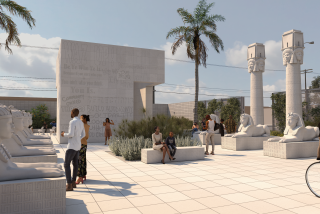Moore Takes Oceanside Civic Center Design Prize
- Share via
OCEANSIDE — Perhaps it was the grove of greenery at Hill and 3rd streets. Or maybe it was the familiar style of Irving Gill. It could have been the courtyard pool with its underground stream bubbling out into the open space or the bright-colored tiles around the entrance arch.
Whatever it was, the conservative design of UCLA architectural program head Charles Moore and his associates won out during a 10-hour selection marathon over four other designs that included stepped pyramids and slender high-rises. The winning design, announced Monday, won its creators a $10,000 prize and the right to negotiate for construction of the Oceanside civic center.
The civic center is scheduled to be completed during 1988--the city’s 100th anniversary--to allow for mid-year dedication ceremonies as part of the centennial celebration and to spur the city’s sagging redevelopment program.
Construction on the $17.5-million project will start next January, with city workers expected to move in by January, 1989. Funding will come from the sale of city redevelopment bonds.
An 11-member jury of architects and townsfolk labored long Saturday to select the winner in an exercise that one of the jurors, Councilman John MacDonald, labeled “an exhilarating experience”--with a pained expression on his face.
Architect Moore described his winning design in an accompanying brochure as “a clear, simple and honest architecture that luxuriates in the temperate climate and lush landscape of coastal Southern California.”
The complex of one-, two- and three-story buildings will be located on a three-square-block site between 3rd, 4th, Nevada and Hill streets. Included in the center will be a city hall, main city library, Oceanside Harbor administration headquarters, a parking garage and buildings to house the various city departments that now are spread out in rented quarters throughout the city.
The buildings will be of a plain, white-concrete, squared design, reminiscent of the architecture of the city’s first municipal structures designed by the respected local architect Irving Gill. The new design retains Gill’s fire station as an administration building, but not Gill’s city hall building next door.
Moore salutes Gill’s legacy: “We use his plain white walls, his unadorned concrete arcades, disciplined fenestration and flat roofs as our architectural vocabulary, and then allow ourselves the exuberance of bright colors with tiles in niches at the entrances, in the jambs and soffits of deep set openings, and through the contrast of palms and broad-leafed plants surrounding our structure.”
MacDonald described the city center architecture as “having a mission style, a Gill flavor and a lot of Moore in it.” He said it was one of his two favorites because it “is a blend of old and new,” has a functional design, will require low maintenance and “looks like Oceanside.”
Doug Danielson, president of Danielson Design Group of San Juan Capistrano and part of the winning architectural team, said the complex could be constructed within the city’s pared-down construction costs of slightly more than $12 million without harming the design or sacrificing construction integrity.
Danielson’s firm also is involved in the restoration of the Oceanside city pier. He said that his design group had sought out Moore, a nationally recognized architect, and put together a joint venture with his own firm, which has a reputation for bringing in projects on time and within budget.
An Oceanside resident, Lorene Logan, told The Times Monday that a conflict of interest existed in the award of the design prize to the Moore-Danielson group because Danielson’s mother-in-law, Louise Burch, is a member of an advisory committee to the Oceanside Redevelopment Agency.
Mayor Larry Bagley called the charge “absolutely ridiculous,” saying Burch had no part in the design competition nor did her advisory committee.
Bagley added that although the chosen design was not his personal favorite among the five finalists, “it’s just fine with me. What do I know? I went down there (to the display of architectural models) five times and changed my mind three times.”
More to Read
The biggest entertainment stories
Get our big stories about Hollywood, film, television, music, arts, culture and more right in your inbox as soon as they publish.
You may occasionally receive promotional content from the Los Angeles Times.










